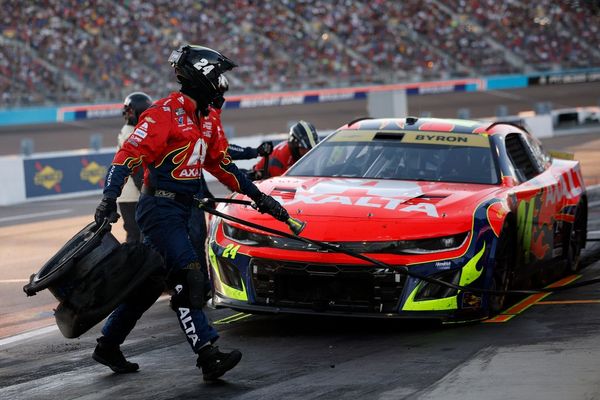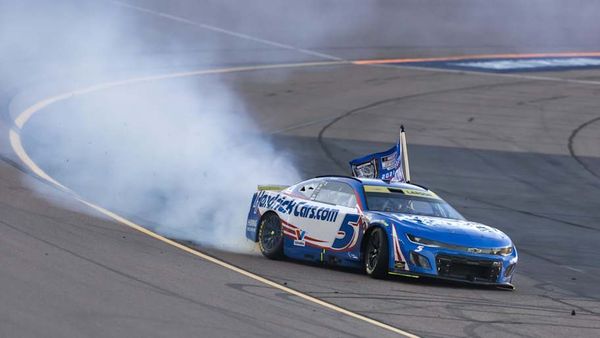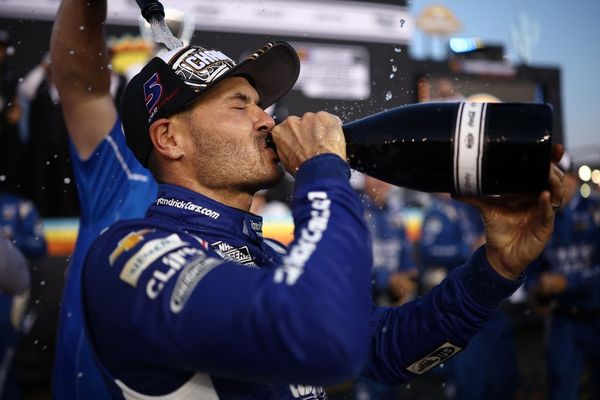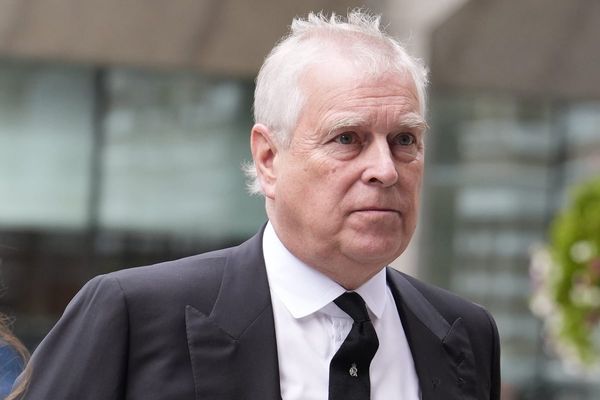It’s getaway week in the NFL before teams return in late July for training camps. So we’ve got some things to get to …
This is a critical juncture for the Jaguars’ franchise. That much was clear to me Friday after catching up with Jacksonville president Mark Lamping, a few days after plans were unveiled to gut TIAA Bank Stadium and essentially put a new venue in its place for between $1.3 billion and $1.4 billion. And it was most clear when I asked Lamping straight up whether the future of the team in North Florida is tied to the fate of this project.
He’s optimistic, to be sure, that the Jaguars will land the funding they need to go forward with what they’ve spent nearly seven years working on. But the truth is, they have to be.
“What we said, Albert, is we cannot extend our lease in Jacksonville without a solution to the current stadium,” Lamping says. “And we’ve been pretty direct with that. That was the premise when we first started talking about this in 2016. We focused on those cities that have found themselves in bad situations and wanted to do everything we can to avoid that. Whether you look at St. Louis, Oakland, San Diego, all those situations had several things in common.
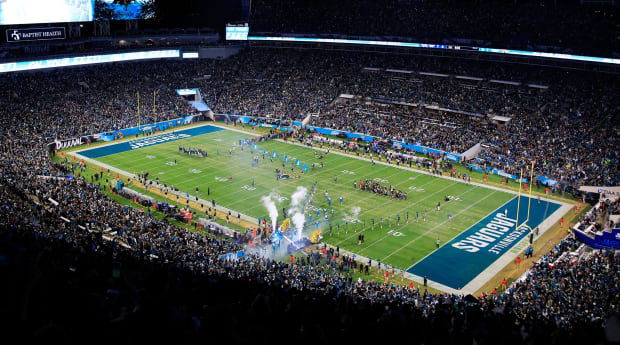
Corey Perrine/Florida Times-Union/USA TODAY NETWORK
“They were generally smaller markets, [and] they had aging stadiums without a stadium solution. And the team was not compelled by any lease to have to stay in that market. Unfortunately for the NFL fans in those communities, they lost their team. That’s not any type of situation that we want the fans in northeast Florida to endure. It was because of that, that we tried to get so far ahead of this.”
They got ahead of it by researching both the idea of building a new venue and renovating the current one. They got ahead of it by doing exhaustive engineering studies. They got ahead of it by working with fans, and with national governing bodies that control big events, and with the universities of Florida and Georgia (who play their rivalry game in the stadium) to troubleshooting any and all blueprints they laid out for the future.
And they came to a bunch of conclusions.
• The old Gator Bowl could sustain a second overhaul—after being reconstructed to house the Jags in the first place in the mid-1990s. “The first renovation was essentially a new build,” Lamping says. “We only kept one side of the stadium. And then the super structure that they put in beneath the current version of the stadium that was done in the mid-’90s, it was well thought out, it’s structurally sound and its useful life can be extended. What can’t be extended is everything that’s attached to that super structure system. And that’s our approach. It’s more of a gut rehab than a renovation. We think we’ll end up with essentially all the benefits of a new stadium and we’ll be able to do it at a significantly lower cost.”
• What does significantly lower cost mean? It means saving a billion—the cost Lamping and his team were looking at for a new stadium in Jacksonville would be $2.4 billion.
• Public money would have to be incorporated. And Lamping says this having come to Jacksonville from a job as CEO of the privately financed venue, MetLife Stadium, that houses the Jets and Giants. “We watched very closely what was happening not only in Buffalo but what happened in Nashville, what has happened in Baltimore, what happened in New Orleans—all of those are comparable markets. It’s amazingly consistent what you see, that in the bottom quartile of NFL market teams, the arrangement for stadium construction involves a hefty investment from the public sector,” Lamping says before conceding, “That’s not the case in the big markets. I was up in New York before I came down to Jacksonville, and with MetLife Stadium, there wasn’t a significant public involvement in that project.”
• That public contribution to the stadium the Jags are looking for would pay for more than half the bill. But, Lamping says, “We’ve done partnerships with the city of Jacksonville; we’re doing one right now with our practice facility. We did one with the music venue we built. Those have worked really well and they’ve been 50-50 cost-shared. What the framework of this agreement is, there’s a bigger project, which includes the stadium and the development outside the stadium, that will be 50-50.”
• If funding is secured, moving out of the stadium for a couple of years while the work is being done is the most cost-effective way of managing the project. In that scenario, the Jags would be out of the stadium in 2026 and ’27, and back in the rebuilt structure in ’28. If the Jags try to play in the stadium through the construction, it’ll impact four seasons, rather than two, and add about $200 million to the total cost, according to Lamping (we’ll have more on the temporary sites in our next takeaway).
• And, yes, SoFi Stadium is the inspiration for a lot of the drawings you’ve seen. Or at least part of it. “Yeah, the inspiration for SoFi is more related to the roof structure,” Lamping says. “SoFi is an open-air stadium that has a permanent roof covering the seats and the field. And that works in the Southern California climate. It’ll also work in northeast Florida. So if they’re just comparisons, that’s the biggest comparison. We have a roof, a permanent roof over the stadium that provides shade on all the seats, it provides protection from the rain, it provides protection in severe weather conditions that we get occasionally in Northeast Florida. But it’s open air.” And, yes, they’re keeping the pools. Also, Lamping describes the exterior of the stadium’s PFTE fabric, which is what wraps around the structure in the renderings, will almost be like looking out a set of mirrored sunglasses from inside.
Of course, that’s assuming the stadium gets built, and obviously there are still a few hoops for the NFL and the Jaguars to jump through on this one.
But if it does get done, the idea of NFL games in Daytona is pretty fun. During our conversation early Friday morning, Lamping raised the possibility to me, and there’s no question that, without knowing whether it would work, the idea of having NFL games at an iconic race track was a little more fun than putting them in Gainesville or Orlando.
“They have had football down there,” Lamping says. “The University of Tennessee played at Bristol [Motor Speedway]. And keep in mind, that facility is probably the closest of those three facilities to Jacksonville. From where I live, it’s 60 miles down to Daytona. And they’re used to handling crowds of over 100,000. So the traffic and the parking and all of that, they handle in a major way twice a year with their two NASCAR races.
“So they’re going to be interesting.”
Now, Lamping said the Jaguars have already shared with officials in Gainesville (Florida Field) and Orlando (Camping World Stadium) what the NFL would require for them to host games, and they aren’t that far down the road with Daytona. That said, Lamping says he has “had discussions, but I haven’t met with the speedway yet. That’s on the books for the next week or two.”
Still, Orlando and Gainesville would probably be the most practical temporary homes, with those two needing only some to get to broadcast requirements the NFL has for its games (lighting upgrades could be one), and being turnkey otherwise. Listening to Lamping, it seems a little less likely that the team will choose one of its in-town options.
“We’ve looked at two temporary solutions in Jacksonville,” he says. “There’s a Triple A baseball stadium we could add 20,000 seats to. There’s a track and field stadium at the University of North Florida we could add 20,000 seats to. That’d get us to a capacity of 30,000, which would be very similar to what the Chargers did when they were waiting for SoFi.”
The problem, in both those cases, would be that it’d probably cost around $125 million to get those venues to NFL code, which would go against the team’s efforts to keep spending on the overarching project.
I wouldn’t dismiss the idea of Saudi money eventually getting to the NFL. I had a mailbag answer Wednesday that got some attention. The background of it is that, at the start, I’d set out to answer a reader’s question on whether the Saudi involvement we’re now seeing in golf would ever trickle into pro football. I figured I’d get the idea shot down very quickly. Instead, two team president types went the other way entirely.
Now, I certainly don’t think this is happening tomorrow.
But, eventually, I could see the league going there, because they’re going to need buyers for franchises that are becoming increasingly unaffordable, even for the wealthiest of the wealthy. It’s in NFL owners’ interest, obviously, for the price tags on teams to keep rising, and to make that happen they’ll need people capable of moving what’s becoming an unmovable needle for almost anyone on the planet.
The next question, then, would be whether the Saudis have an interest, and I believe they would have an interest in bringing an NFL game to their country. The current government is looking to diversify its economy, with the future of oil unstable, and that’s happening with investments in sports and tourism. And if the NFL won’t bring a game to Saudi Arabia on its own, then the Saudis’ solution could be to buy a team, and have it play a game or two a year over there.
Let’s say, for example, a team out there is looking for public funding for a new stadium and can’t find it, and the owners don’t want to have to foot the bill to construct a stadium on their own. Could the Saudis then buy that team, with the promise they’ll build the stadium on the condition the team plays a game a year in Riyadh, like the Jags do in London? And wouldn’t the investment in an NFL team be sound for the Saudi Public Investment Fund?
It’s an interesting idea. And, again, it’s not one I think NFL owners would approve next week. But, certainly, given the ties the league already has to the Saudis—Cowboys owner Jerry Jones has well-documented relationships over there—it doesn’t take too much in the way of mental gymnastics to get yourself to a place where such a scenario could play out, say a decade or two from now.
Obviously, the league would have to reckon with the questions of morality, and specifically whether it wants to be tied to the Saudis’ human rights record. But the NFL has done business with China and is partners with Nike, so it’s not like they haven’t held their noses and looked the other way in the past. Especially when the connector is money, the key element in a pretty significant number of NFL changes of heart in the past.
Need an example? Go look up what Roger Goodell was saying about gambling 10 years ago.
My guess is DeAndre Hopkins, as has been the case for a while, will have to decide what’s most important to him in picking a team. This is not a good juncture to be a free agent. Most teams have hit their budgets—both cap- and cash-wise—for the offseason, which makes this a much different time to be on the market than mid-March.
So this isn’t really about what Hopkins is worth based on his history and production. It’s about what he’ll be able to get based on the calendar and his trajectory as a player.
I hit up a couple of team execs Sunday to try to get a value on him. One said that if he were a free agent in March, he’d still see Hopkins as an $18 million player on a multiyear deal, but “it’s such a strange time to reach the market; everyone has already spent and allocated.” Another guessed he’d get between $8 million and $10 million on a one-year deal, with some upside built in to make him whole if he could produce at his accustomed level.
If I I had to take a stab at it, I’d say the latter guess is in the neighborhood of what he gets, if Hopkins just chooses the highest bidder (which, honestly, no one should blame him as a 31-year-old player who hasn’t played a full season in three years). And I’d say that’s probably what Hopkins will do, since he already walked away from shots to chase a ring in Buffalo and Kansas City, which would represent his two best shots, by far, to do so.
Could the Chiefs or Bills get involved again? Sure they could. He’d just have to take less—and by that, I mean maybe even less than those two proposed when they engaged the Cardinals in trade talks back in April, way before Hopkins was released. Since, the Chiefs have spent on Donovan Smith and the Bills have spent on Leonard Floyd, and both have less than $5 million to work with under the cap, meaning they’d have to push money into future years to go past that on a one-year deal.
As you’re reading this, Hopkins is in Nashville with the Titans. He’ll visit the Patriots next. And given all of the above, I don’t see why money wouldn’t be the deciding factor now.
Unless, that is, he has a change of heart on what he’s willing to walk away from to play for a top contender.
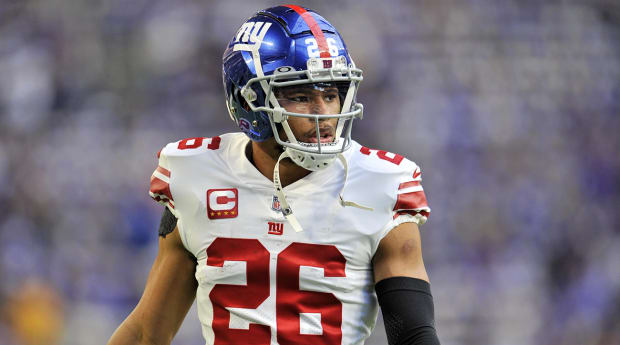
Jeffrey Becker/USA TODAY Sports
I appreciate the sentiments of Josh Jacobs and Saquon Barkley this week—but I’m not sure it’s going to make much of a difference. Both guys are franchise-tagged. Neither has signed his tender. And just as Jacobs skipped Raiders minicamp last week, Barkley confirmed his plans to skip Giants minicamp this week.
I do feel for both of them, because neither is in a great negotiating position.
It’s just what that position is in today’s NFL, and, more than just that, how replaceable just about every running back is seen in an era when one Super Bowl team (Kansas City) started a seventh-round rookie (Isiah Pacheco) and the other let its starter at the position from last year (Miles Sanders) go without much of a fight.
On Saturday, Jacobs tweeted, “Sometimes it’s not about you. We gotta do it for the ones after us.” Barkley, for his part, took a more realistic tact in telling the media at his football camp: “As I’ve previously stated, I’m not looking to set any contract record. I’m not demanding to be the highest-paid player at my position. I understand the market. My goal is just to be compensated respectfully based on my contributions to the team on the field and in the locker room. I’ve been in talks with the Giants throughout the offseason. If at some point there’s a deal that’s fair to both sides on the table, I’ll be ready to sign.”
Unfortunately, for Jacobs, there’s probably nothing he can do to reverse the trend of backs having to take less and less on extensions and on the open market. And unfortunately for Barkley, what winds up being fair at the mid-July deadline for tagged players to do long-term deals might be a little less than he has in mind.
To be clear, both of these guys are great players who have offenses built around them and, by all accounts, are really good guys, too.
But if I were advising them? I’d say, when we do get to that deadline (4 p.m. ET July 17), take every guaranteed dollar you can and don’t look back. Because history (see: Bell, Le’Veon) doesn’t look kindly upon players at that position who’ve carried contract disputes over multiple years. And once the money’s gone at that position, it’s almost always gone for good.
Dalvin Cook would be another good example of that. If you go back and look, the then Vikings workhorse didn’t really crush it contract-wish, in 2020, after posting 1,554 scrimmage yards. His deal was advertised as a five-year, $63 million deal, which fell short of the $15 million average annual value he was seeking, and gave the team the chance to bail, if it so desired, after just two years.
Indeed, less than three years after doing the deal, the Vikings released Cook.
But guess what? He’s still the winner here. Had he played hard ball and not done that deal in September 2020, he’d have played that season at $1.33 million. Maybe, after posting a career year (more than 1,900 scrimmage yards), someone would have broken the bank for him as a free agent in ’21. Maybe not.
Instead of trying his luck at that, Cook wound up making $27.22 million over the three years to follow. Subtract what was left on his rookie deal above from that total, and he got nearly $26 million for giving the Vikings those two years of service.
That’s almost $13 million per year. By comparison, the top earning backs on the free-agent market in March—Carolina’s Miles Sanders and Detroit’s David Montgomery—got around $6 million, and that was after taking on the injury risk of playing out the final years of their respective rookie contracts.
So here’s hoping Jacobs and Barkley (and Tony Pollard, too) act pragmatically, and not too emotionally, over the next few weeks.
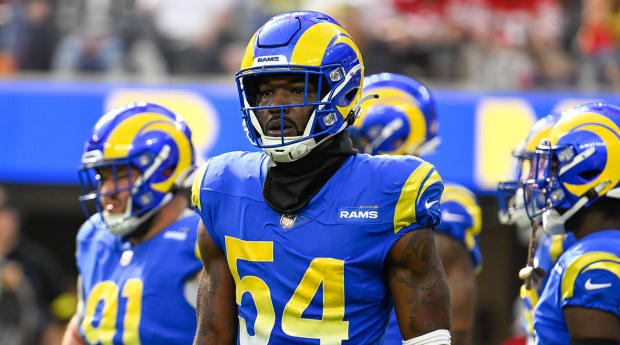
Robert Hanashiro/USA TODAY Sports
On the flip side, even aging pass rushers get paid, and in June. Leonard Floyd certainly didn’t get as much as he’d hoped in doing his deal with the Bills. Ditto for Frank Clark’s new contract with the Broncos. But given the circumstances? I’d say both made out just fine. Here are the details …
• Floyd did a one-year deal with the Bills with $7 million in base pay. If he gets eight sacks, it will go to $7.5 million. At 10 sacks, he’ll get $8 million. And at 12 sacks, he’ll get $9 million.
• Meanwhile, Clark, who wasn’t as productive as Floyd last year, got a $5.51 million base salary in Denver. He’ll get another $500,000 if he plays 60% of the snaps and the team wins six games, or he has six sacks. He gets $500,000 bumps from there at eight, 10 and 12 sacks, which pushes that max value to $7.5 million.
Remember, Clark turns 30 next week, and had six, 4.5 and five sacks his past three seasons. And Floyd, who’ll be 31 for the Bills’ opener, has slid a bit, going from 10.5 to 9.5 to nine sacks over the past three years. So while Jadeveon Clowney, Yannick Ngakoue and Justin Houston may not be looking at breaking the bank, Floyd and Clark have shown that teams will pay for pass rushers, even if they’re older and have sat on the market for months.
Chase Young moved the needle at minicamp last week. You know the story of the Commanders’ 2020 first-rounder. Star potential as a rookie. Catastrophic knee injury in Year 2. A struggle in Year 3 to come back. Fifth-year option declined heading into Year 4.
The uncertainty surrounding Young, and his absence from most of the team’s offseason program, had a lot of folks across the NFL wondering where Washington stood on its would-be star pass rusher—particularly since the Commanders just paid Daron Payne and Jonathan Allen and had a third star defensive linemen, DE Montez Sweat, going into a contract year. And there was a time, leading up to the draft, when Washington was open to listening if teams had something significant to offer for Young.
I got the idea over the past few days that that time is now over.
After his ability to move around in practice at the end of last year elicited serious internal concern on his future after the 2021 knee injury, Young reported to his team for last week’s mandatory work and looked like himself, to the point where the Commanders are optimistic they could be getting the ’20 version of Young back after all.
And in a year with so much on the line for so many in the organization, I can’t imagine the Commanders are going to walk away from the possibility that’s the Young they’re getting, especially when you figure future assets are what they’d have coming back for him.
So I’m betting on Young being a Commander (and a real good one) come September.
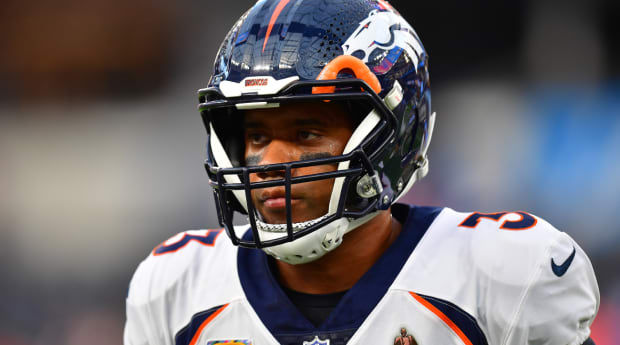
Gary A. Vasquez/USA TODAY Sports
It’d be unfair to not note what’s being said about Russell Wilson in Denver now after chronicling what went down there in 2022. And so let’s just say I definitely took note of how left tackle Garett Bolles spoke about his quarterback last week—gushing over Wilson while talking to reporters at Broncos OTAs.
“He’s a great dude. He’s the same guy every single day. He works his butt off,” Bolles said. “And I’m ready for that stuff to go away and when it goes, everyone’s going to eat crow.”
Bolles wasn’t done.
“I think he’s phenomenal,” Bolles said Thursday. “I love him dearly. I think he’s one of the greatest quarterbacks in the game the last 10 years. Stats don’t lie. Just because you have one rough season in the last 10 years, you can’t dictate what type of guy, his personality, what he goes through."
Bolles then said Wilson was “angry” with what came out last year, and that he’s taken it “very personal” and, well, you get the idea.
If Bolles is being forthright, and there’s no real reason to think that he wouldn’t be, my guess would be Wilson gained some self-awareness going through what he did last year. And if that is the case, then my guess would be he’d throw his trust into how Sean Payton sees him best deployed as a quarterback.
Which would be awfully good news for a Denver team that remains deeply invested in its quarterback.
There’s a reason you’re hearing a lot about the NFL’s efforts to educate players on its gambling rules. And my guess is that reason is the defense some players and their agents are mounting against accusations made as the league continues to investigate a sizable number of guys for violations of the policy.
That defense? Players understand that they can’t gamble on NFL games. But many contend they didn’t have rules prohibiting them, say, placing a bet on an NBA game from their locker room properly communicated to them.
So now it appears the NFL is going over the top and getting it out there that they’re using guys such as Tom Brady as teachers to deliver the message. Which actually makes sense, since no one really wins when a star player is getting popped for betting on an NCAA tournament game on his phone from the weight room.
(We can leave the hypocrisy discussion here—remember, these guys play games in the Caesars Superdome—for another day.)

